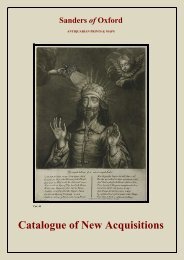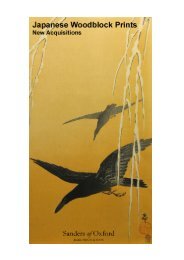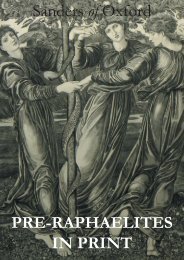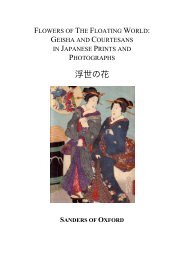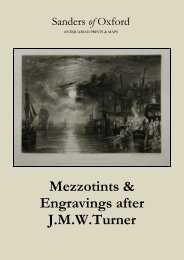catalogue text.indd - Sanders of Oxford
catalogue text.indd - Sanders of Oxford
catalogue text.indd - Sanders of Oxford
You also want an ePaper? Increase the reach of your titles
YUMPU automatically turns print PDFs into web optimized ePapers that Google loves.
Joseph Constantine Stadler (fl. 1780 - 1822) was a printmaker <strong>of</strong> German origins. He settled in London in the 1780’s<br />
and, since he specialized in aquatint engraving, became responsible for the successful production <strong>of</strong> many ambitious<br />
topographical works. Amongst these were Philippe Jacques de Loutherbourg’s ‘Picturesque Scenery <strong>of</strong> Great Britain’,<br />
as well as numerous commissions for Rudolph Ackermann including ‘Views <strong>of</strong> London’, and ‘Public Schools’.<br />
John Raphael Smith (1751 - 1812) was an English painter, printmaker and publisher. After abandoning a career in<br />
linen drapery, Smith became one <strong>of</strong> the leading printmakers <strong>of</strong> the day. He excelled in mezzotint, and produced numerous<br />
plates after portraits by Gainsborough, Reynolds, and Romney. In adition to his reproductive work, he was<br />
also a highly successful publisher and seller <strong>of</strong> prints, and exported a large number <strong>of</strong> material to France. However, the<br />
outbreak <strong>of</strong> the Napoleonic Wars in 1803 destoyed this market, and Smith announced his retirement from printmaking<br />
in order to produce pastel portraits <strong>of</strong> his own up until his death in 1812.<br />
John Thompson (1785 - 1866) was a distinguished English wood engraver. He trained under Allen Robert Branston,<br />
and then held a long standing collaboration with the artist John Thurston. He is believed to have engraved approximately<br />
nine-hundred <strong>of</strong> Thurston’s designs over the course <strong>of</strong> his career. Thompson was also a popular book illustrator<br />
and produced the prints for William ‘Yarrell’s History <strong>of</strong> British Birds’, 1843. The crux <strong>of</strong> his fame however was<br />
monetary, as in 1852, Thompson created the figure <strong>of</strong> Britannia which would appear on British banknotes for the rest<br />
<strong>of</strong> the nineteenth-century.<br />
Charles Turner (1774-1857) was was an English mezzotint engraver and draughtsman. Hailing from Woodstock,<br />
<strong>Oxford</strong>shire, Turner moved to London at the age <strong>of</strong> fifteen. He enrolled in The Royal Academy and, like many other<br />
engravers <strong>of</strong> the time, initially relied upon the patronage <strong>of</strong> wealthy and influential people. Turner had the considerable<br />
backing <strong>of</strong> the Marlborough family, for his grandmother had been a close companion <strong>of</strong> the Duchess. This relation<br />
led to important commissions. Turner would, for instance, engrave the Marlborough family portrait after the painting<br />
by Sir Joshua Reynolds. He was subsequently employed by the influential publisher John Boydell. Diversely gifted,<br />
Turner was as adept in the medium <strong>of</strong> mezzotint as he was in stipple and aquatint. This leant great scope to the subjects<br />
he could depict. Whether it was the engraving <strong>of</strong> Van Dyck or Rembrandt, or the topography <strong>of</strong> his namesake,<br />
Turner excelled.<br />
Jan Wandelaar (1690 - 1759) was a Dutch draughtsman and etcher who was mainly active in Amsterdam. He was<br />
believed to have been a pupil <strong>of</strong> Johannes Jacobsz Folkema, Gilliam van der Gouwen, and Gerard de Lairesse. Wandelaar<br />
produced engravings after Jacob Houbraken, as well for Carl Linnaeus’ Hortus Cliffortianus and Bernhard Siegfried<br />
Albinus’ Tabulae sceleti et musculorum corporis humani.<br />
John Whessell (1760 - 1833) was an English engraver working in London between the years <strong>of</strong> 1802-1823. He then<br />
flourished in <strong>Oxford</strong> during the latter half <strong>of</strong> the same decade. It is here that he both drew, and engraved views for<br />
<strong>Oxford</strong> Delineated published in 1831 by Whessell and Bartlett. He engraved works after Serres, Stothard, Singleton,<br />
Sartorius and Gainsborough, amongst others. ‘The Durham Ox’ that he engraved after John Boultbee went on to become<br />
one <strong>of</strong> the most famous images <strong>of</strong> the nineteenth-century.<br />
Cartographers<br />
Petrus Bertius (1565 – 1629) was a Flemish theologian, historian, geographer and cartographer. Following his appointment<br />
to the Pr<strong>of</strong>essor <strong>of</strong> Mathematics at the University <strong>of</strong> Leiden, Bertius established his cartographic reputation. This<br />
came in 1600 with his <strong>text</strong> for the ‘Tabularum geographicarum contractarum.’ His work was a re-issue <strong>of</strong> the ‘Caert<br />
Thresoor,’ which was originally published in 1598 by Barent Langenes, but provided engravings from the celebrated<br />
hands <strong>of</strong> Jodocus Hondius and Petrus Kaerius. Bertius also gained prominence for his ‘Theatrum Geographiae Veteris.’<br />
Once again, it was a re-issue, but this time it took the celebrated foundation <strong>of</strong> Ptolemy’s ‘Geographia’. Published<br />
in 1618 and 1619, Bertius based his work on Gerard Mercator’s edition <strong>of</strong> 1578. Against the advice <strong>of</strong> fellow Remonstrants,<br />
Bertius published the Hymenaeus Desertor; a theoretical work with an overly zealous take on Arminius’ writings.<br />
He subsequently lost his credibility and teaching position in the Netherlands, so emmigrated to France. In 1618<br />
he moved to Paris and became the Official Cosmographer to Louis XIII.<br />
Willem Blaeu founded the business in 1596. It initially functioned as a globe and instrument makers, but soon expanded<br />
into maps, topography and sea charts. The Atlas Novus was Willems great work; a major work which intended to<br />
include the most up-to-date maps <strong>of</strong> the entire world. He issued the first two volumes in 1635, but died in 1638 before<br />
the atlas was completed. The running <strong>of</strong> the business was passed on to his sons Johannes and Cornelius, in addition to





